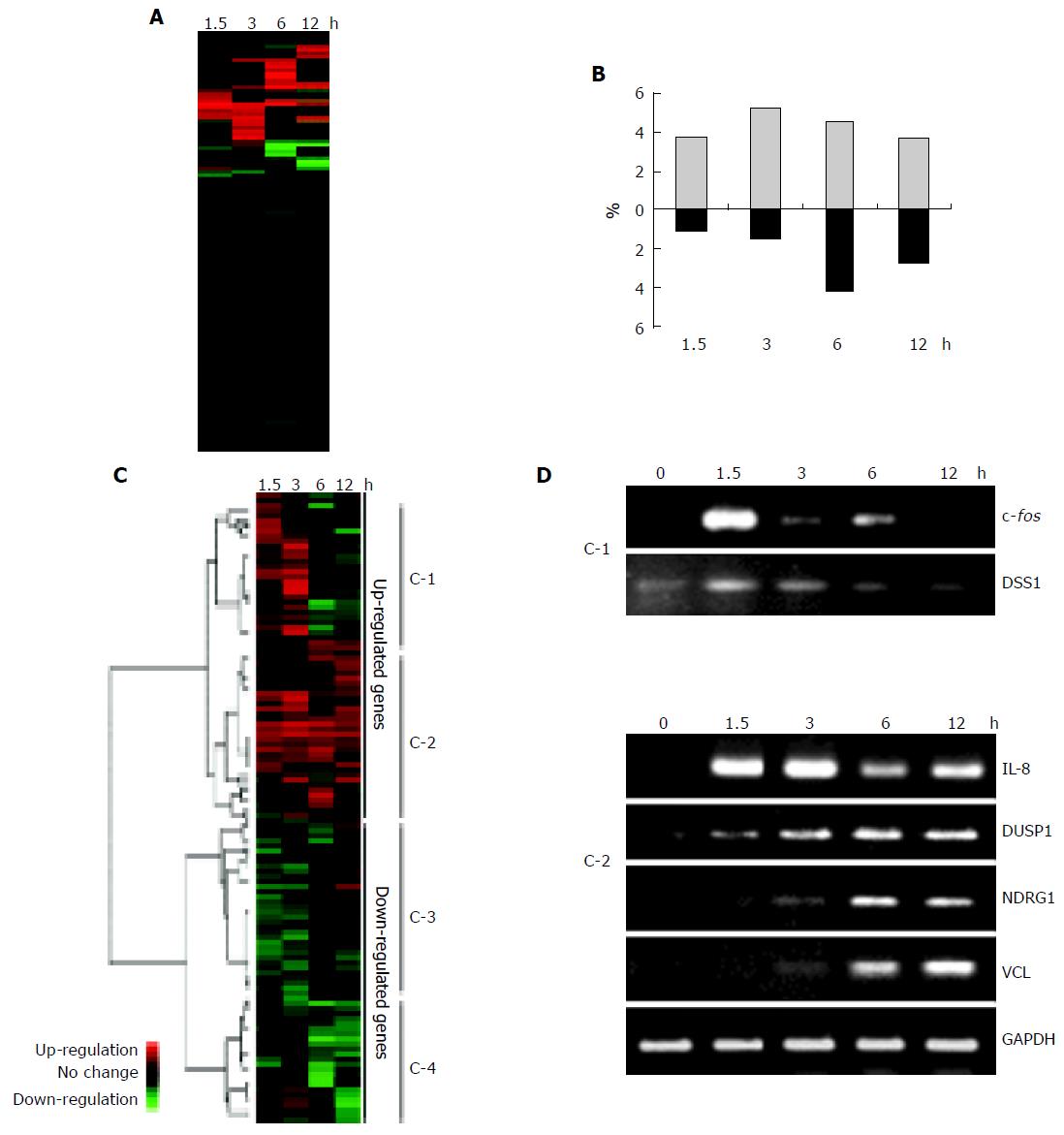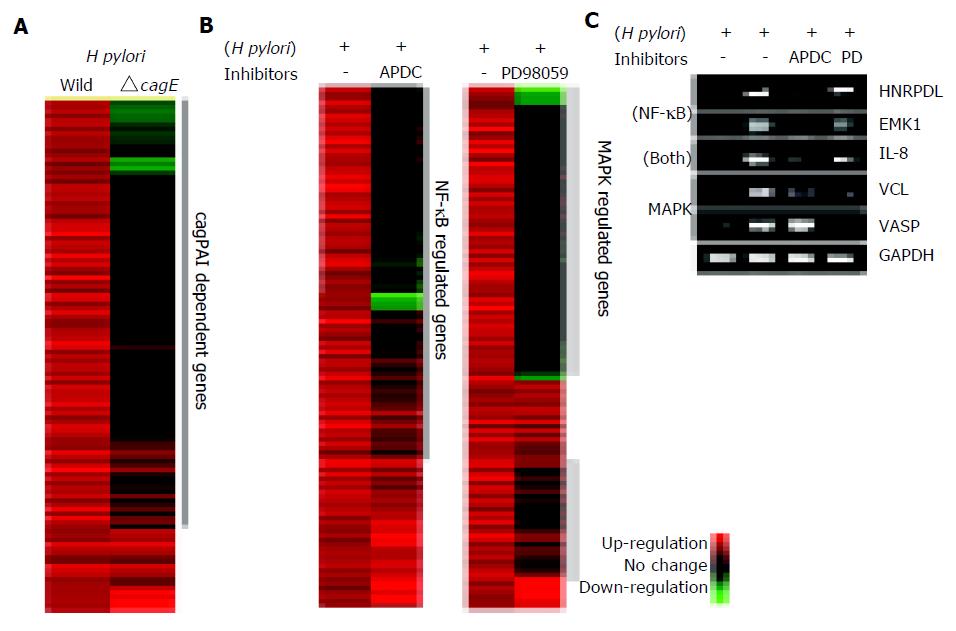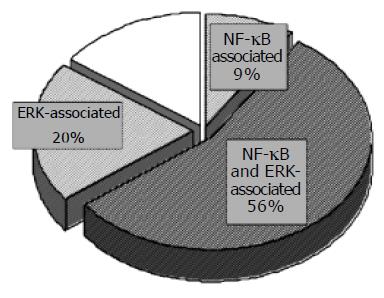Copyright
©The Author(s) 2005.
World J Gastroenterol. Oct 21, 2005; 11(39): 6134-6143
Published online Oct 21, 2005. doi: 10.3748/wjg.v11.i39.6134
Published online Oct 21, 2005. doi: 10.3748/wjg.v11.i39.6134
Figure 1 A: Schematic representation of the genes affected by wild-type H pylori-infection during 12 h in AGS cells.
Red or green indicates up- or downregulation, respectively. About 20% of all the analyzed genes were significantly altered during infection experiments in vitro. Changes in expression with a factor of 3 or greater in either direction were considered significant; B: The percentage of the altered genes at each time point. The upregulated genes reached maximum number at 3 h after wild-type H pylori-infection, but the downregulated genes peaked at 6 h after infection; C: Cluster diagram of gene expression in AGS cells. The rows correspond to 3 228 genes for which the level of expression in AGS was changed by infection with wild-type H pylori, and the columns represent the various time points (1.5, 3, 6, and 12 h after wild-type H pylori-infection from left to right, respectively). Red or green indicates up- or downregulation, respectively, compared with the expression level in uninfected AGS cells. The dendrogram on the left and the horizontal distances between the nodes represent the statistical similarities between the neighboring genes and clusters. The genes were divided into two large clusters, comprising upregulated or downregulated genes. Each of the large clusters contained two smaller clusters, resulting in four clusters (C-1 to C-4; see Results for description); D: Validation of the microarray results by RT-PCR. Total RNAs from wild-type H pylori-infected AGS cells were isolated at the indicated times and subjected to reverse transcription and PCR with specific primers. The bands of the size corresponding to the expected length of the amplified fragment for each specific transcript were analyzed by agarose gel electrophoresis, along with GAPDH as a loading control.
Figure 2 A: The contribution of the cagPAI-coded type IV secretion system to the gene expression profile in AGS cells.
Hierarchical clustering of genes induced by H pylori with or without a functional type IV secretion system (wild type or cagE mutant, respectively). Left lane; gene expression profile of AGS cells co-cultured with wild-type H pylori relative to control. Right lane; gene expression profile of AGS cells co-cultured with the isogenic mutant cagE. Only the 566 significantly upregulated genes at 3 h are shown. About 84% of the genes were induced only by the wild-type H pylori infection. These genes were supposed to be induced by the presence of cagPAI-coded type IV secretion system. B: The contribution of NF-kB or ERK pathways to the gene expression profile. Inhibitors specific for NF-kB or ERK were added to AGS cells co-cultured with H pylori. The gene expression profiles in the presence or absence of the inhibitors were compared. C: The changes in the expression of some representative genes were confirmed by RT-PCR. All genes were induced by wild-type H pylori infection, and suppressed by the incubation with inhibitors of specific signal pathways.
Figure 3 Schematic representation of the distribution of genes affected by wild-type H pylori infection.
The complete upregulated genes at 3 h after infection is represented by the circle as a whole. The expression of 367 genes (65%) of the 566 genes upregulated by wild type H pylori was suppressed by pre-incubation with APDC, an inhibitor of NF-kB. On the other hand, pre-incubation with PD98059, an inhibitor of ERK, suppressed the expression of 429 genes (76%) of the 566 genes upregulated by wild type H pylori. Expression of 475 of the 566 genes (84%) was induced under NF-kB and/or ERK signaling activation, whereas changes in the remaining 16% are NF-kB or ERK signaling independent.
Figure 4 Characterization of the upregulated genes co-cultured with H pylori for 3 h (n = 566).
A: The bar represents the number of 566 upregulated genes among 3 228 analyzed genes (566 genes). B: The genes induced by cagPAI-positive H pylori infection among the 566-H pylori-induced genes (476 genes). C: The contribution of NF-kB or ERK signaling pathway among thecagPAI-dependent gene expression. Among the 476-cagPAI-dependent genes, 66% (315 genes) were also involved in the NF-kB- and/or ERK-signaling activation, whereas 34% (161 genes) of 476 genes were dependent on cagPAI but not involved in either NF-kB or ERK signaling activation.
-
Citation: Shibata W, Hirata Y, Yoshida H, Otsuka M, Hoshida Y, Ogura K, Maeda S, Ohmae T, Yanai A, Mitsuno Y, Seki N, Kawabe T, Omata M. NF-kB and ERK-signaling pathways contribute to the gene expression induced by
cag PAI-positive-Helicobacter pylori infection. World J Gastroenterol 2005; 11(39): 6134-6143 - URL: https://www.wjgnet.com/1007-9327/full/v11/i39/6134.htm
- DOI: https://dx.doi.org/10.3748/wjg.v11.i39.6134
















